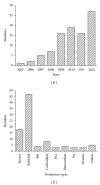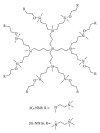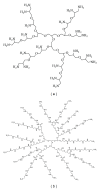Dendrimers as carriers for siRNA delivery and gene silencing: a review
- PMID: 24288498
- PMCID: PMC3830781
- DOI: 10.1155/2013/630654
Dendrimers as carriers for siRNA delivery and gene silencing: a review
Abstract
RNA interference (RNAi) was first literaturally reported in 1998 and has become rapidly a promising tool for therapeutic applications in gene therapy. In a typical RNAi process, small interfering RNAs (siRNA) are used to specifically downregulate the expression of the targeted gene, known as the term "gene silencing." One key point for successful gene silencing is to employ a safe and efficient siRNA delivery system. In this context, dendrimers are emerging as potential nonviral vectors to deliver siRNA for RNAi purpose. Dendrimers have attracted intense interest since their emanating research in the 1980s and are extensively studied as efficient DNA delivery vectors in gene transfer applications, due to their unique features based on the well-defined and multivalent structures. Knowing that DNA and RNA possess a similar structure in terms of nucleic acid framework and the electronegative nature, one can also use the excellent DNA delivery properties of dendrimers to develop effective siRNA delivery systems. In this review, the development of dendrimer-based siRNA delivery vectors is summarized, focusing on the vector features (siRNA delivery efficiency, cytotoxicity, etc.) of different types of dendrimers and the related investigations on structure-activity relationship to promote safe and efficient siRNA delivery system.
Figures










Similar articles
-
A Dual Targeting Dendrimer-Mediated siRNA Delivery System for Effective Gene Silencing in Cancer Therapy.J Am Chem Soc. 2018 Nov 28;140(47):16264-16274. doi: 10.1021/jacs.8b10021. Epub 2018 Nov 1. J Am Chem Soc. 2018. PMID: 30346764
-
Dendrimer Nanovectors for SiRNA Delivery.Methods Mol Biol. 2016;1364:127-42. doi: 10.1007/978-1-4939-3112-5_11. Methods Mol Biol. 2016. PMID: 26472447
-
Delivering siRNA with Dendrimers: In Vivo Applications.Curr Gene Ther. 2017;17(2):105-119. doi: 10.2174/1566523217666170510160527. Curr Gene Ther. 2017. PMID: 28494741 Review.
-
PAMAM Dendrimers as a Delivery System for Small Interfering RNA.Methods Mol Biol. 2020;2115:91-106. doi: 10.1007/978-1-0716-0290-4_5. Methods Mol Biol. 2020. PMID: 32006396
-
Cationic Dendrimers for siRNA Delivery: An Overview of Methods for In Vitro/In Vivo Characterization.Methods Mol Biol. 2021;2282:209-244. doi: 10.1007/978-1-0716-1298-9_14. Methods Mol Biol. 2021. PMID: 33928579 Review.
Cited by
-
Toward a magic or imaginary bullet? Ligands for drug targeting to cancer cells: principles, hopes, and challenges.Int J Nanomedicine. 2015 Feb 17;10:1399-414. doi: 10.2147/IJN.S74514. eCollection 2015. Int J Nanomedicine. 2015. PMID: 25733832 Free PMC article. Review.
-
Silencing of HMGA2 by siRNA Loaded Methotrexate Functionalized Polyamidoamine Dendrimer for Human Breast Cancer Cell Therapy.Genes (Basel). 2021 Jul 20;12(7):1102. doi: 10.3390/genes12071102. Genes (Basel). 2021. PMID: 34356120 Free PMC article.
-
Guanabenz (Wytensin™) selectively enhances uptake and efficacy of hydrophobically modified siRNAs.Nucleic Acids Res. 2015 Oct 15;43(18):8664-72. doi: 10.1093/nar/gkv942. Epub 2015 Sep 22. Nucleic Acids Res. 2015. PMID: 26400165 Free PMC article.
-
Novel PAMAM-PEG-Peptide Conjugates for siRNA Delivery Targeted to the Transferrin and Epidermal Growth Factor Receptors.J Pers Med. 2018 Jan 9;8(1):4. doi: 10.3390/jpm8010004. J Pers Med. 2018. PMID: 29315261 Free PMC article.
-
Interaction of Cationic Carbosilane Dendrimers and Their siRNA Complexes with MCF-7 Cells.Int J Mol Sci. 2021 Jul 1;22(13):7097. doi: 10.3390/ijms22137097. Int J Mol Sci. 2021. PMID: 34281151 Free PMC article.
References
-
- Fire A, Xu S, Montgomery MK, Kostas SA, Driver SE, Mello CC. Potent and specific genetic interference by double-stranded RNA in caenorhabditis elegans. Nature. 1998;391(6669):806–811. - PubMed
-
- Hammond SM, Boettcher S, Caudy AA, Kobayashi R, Hannon GJ. Argonaute2, a link between genetic and biochemical analyses of RNAi. Science. 2001;293(5532):1146–1150. - PubMed
-
- Liu X, Rocchi P, Peng L. Dendrimers as non-viral vectors for siRNA delivery. New Journal of Chemistry. 2012;36(2):256–263.
Publication types
MeSH terms
Substances
LinkOut - more resources
Full Text Sources
Other Literature Sources

